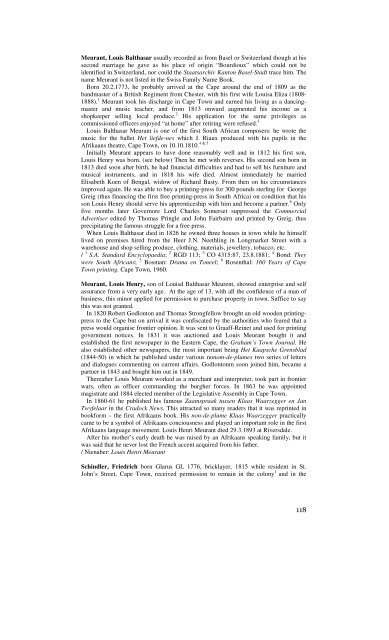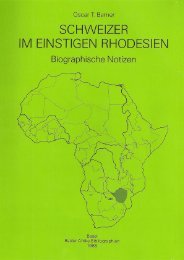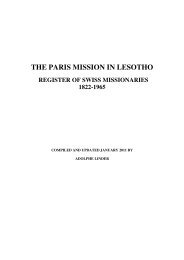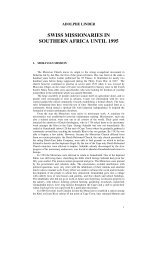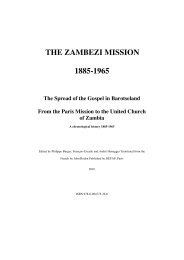THE SWISS IN SOUTHERN AFRICA 1652-1970 - swissroots-za.ch
THE SWISS IN SOUTHERN AFRICA 1652-1970 - swissroots-za.ch
THE SWISS IN SOUTHERN AFRICA 1652-1970 - swissroots-za.ch
Create successful ePaper yourself
Turn your PDF publications into a flip-book with our unique Google optimized e-Paper software.
Meurant, Louis Balthasar usually recorded as from Basel or Switzerland though at his<br />
second marriage he gave as his place of origin “Bourdioux” whi<strong>ch</strong> could not be<br />
identified in Switzerland, nor could the Staatsar<strong>ch</strong>iv Kanton Basel-Stadt trace him. The<br />
name Meurant is not listed in the Swiss Family Name Book.<br />
Born 20.2.1773, he probably arrived at the Cape around the end of 1809 as the<br />
bandmaster of a British Regiment from Chester, with his first wife Louisa Eli<strong>za</strong> (1808-<br />
1888). 1 Meurant took his dis<strong>ch</strong>arge in Cape Town and earned his living as a dancingmaster<br />
and music tea<strong>ch</strong>er, and from 1813 onward augmented his income as a<br />
shopkeeper selling local produce. 2 His application for the same privileges as<br />
commissioned officers enjoyed “at home” after retiring were refused. 3<br />
Louis Balthasar Meurant is one of the first South African composers: he wrote the<br />
music for the ballet Het liefde-nes whi<strong>ch</strong> J. Riaux produced with his pupils in the<br />
Afrikaans theatre, Cape Town, on 10.10.1810.<br />
Initially Meurant appears to have done reasonably well and in 1812 his first son,<br />
Louis Henry was born. (see below) Then he met with reverses. His second son born in<br />
1813 died soon after birth, he had financial difficulties and had to sell his furniture and<br />
musical instruments, and in 1818 his wife died. Almost immediately he married<br />
Elisabeth Koen of Bengal, widow of Ri<strong>ch</strong>ard Basty. From then on his circumstances<br />
improved again. He was able to buy a printing-press for 300 pounds sterling for George<br />
Greig (thus financing the first free printing-press in South Africa) on condition that his<br />
son Louis Henry should serve his apprenticeship with him and become a partner. 6 Only<br />
five months later Governore Lord Charles Somerset suppressed the Commercial<br />
Advertiser edited by Thomas Pringle and John Fairbairn and printed by Greig, thus<br />
precipitating the famous struggle for a free press.<br />
When Louis Balthasar died in 1826 he owned three houses in town while he himself<br />
lived on premises hired from the Heer J.N. Neethling in Longmarket Street with a<br />
warehouse and shop selling produce, clothing, materials, jewellery, tobacco, etc.<br />
/ 1 S.A. Standard Encyclopaedia; 2 RGD 113; 3 CO 4315:87, 23.8.1881; 4 Bond: They<br />
were South Africans; 5 Bosman: Drama en Toneel; 6 Rosenthal: 160 Years of Cape<br />
Town printing. Cape Town, 1960.<br />
Meurant, Louis Henry, son of Louisd Balthasar Meurent, showed enterprise and self<br />
assurance from a very early age. At the age of 13, with all the confidence of a man of<br />
business, this minor applied for permission to pur<strong>ch</strong>ase property in town. Suffice to say<br />
this was not granted.<br />
In 1820 Robert Godlonton and Thomas Strongfellow brought an old wooden printingpress<br />
to the Cape but on arrival it was confiscated by the authorities who feared that a<br />
press would organise frontier opinion. It was sent to Graaff-Reinet and used for printing<br />
government notices. In 1831 it was auctioned and Louis Meurant bought it and<br />
established the first newspaper in the Eastern Cape, the Graham’s Town Journal. He<br />
also established other newspapers, the most important being Het Kaaps<strong>ch</strong>e Grensblad<br />
(1844-50) in whi<strong>ch</strong> he published under various nonom-de-plumes two series of letters<br />
and dialogues commenting on current affairs. Godlontonm soon joined him, became a<br />
partner in 1843 and bought him out in 1849.<br />
Thereafter Louis Meurant worked as a mer<strong>ch</strong>ant and interpreter, took part in frontier<br />
wars, often as officer commanding the burgher forces. In 1863 he was appointed<br />
magistrate and 1884 elected member of the Legislative Assembly in Cape Town.<br />
In 1860-61 he published his famous Zaamspraak tussen Klaas Waarzegger en Jan<br />
Twyfelaar in the Cradock News. This attracted so many readers that it was reprinted in<br />
bookform – the first Afrikaans book. His non-de-plume Klaas Waarzegger practically<br />
came to be a symbol of Afrikaans conciousness and played an important role in the first<br />
Afrikaans language movement. Louis Henri Meurant died 29.3.1893 at Riversdale.<br />
After his mother’s early death he was raised by an Afrikaans speaking family, but it<br />
was said that he never lost the Fren<strong>ch</strong> accent acquired from his father.<br />
/ Nienaber: Louis Henri Meurant<br />
S<strong>ch</strong>indler, Friedri<strong>ch</strong> born Glarus GL 1776, bricklayer, 1815 while resident in St.<br />
John’s Street, Cape Town, received permission to remain in the colony 1 and in the<br />
4 & 5<br />
118


